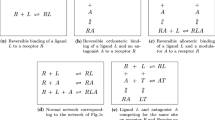The potential relevance of a kinetic model for switch-like behavior in biochemical reactions to pharmacodynamics is explored. This model, which postulates that drug acts by modulating the balance of kinase and phosphatase activities, and their effect on the phosphorylation state of an effector molecule critical in determining drug effect, predicts sharp concentration–effect profiles without explicit incorporation of cooperativity. The degree of sharpness depends on concentration of the critical effector. It is argued that such a model can account for inter-individual differences in pharmacodynamic sensitivity profiles, as well as intra-individual changes in sensitivity associated with time-varying physiological processes or disease. By augmenting the model with a kinetic description of critical effector synthesis and degradation in the nonphosphorylated and phosphorylated forms, a putative mechanism for drug tolerance is revealed. The combined model predicts that tolerance, in addition to attenuating the maximum effect, may lead to a decrease in apparent Hill coefficient.
Similar content being viewed by others
References
Csajka C., Verotta D. (2006) Pharmacokinetic–pharmacodynamic modelling: history and perspectives. J. Pharmacokinet. Pharmacodynam. 33:227–279
Mager D.E., Jusko W.J. (2001) Pharmacodynamic modeling of time-dependent transduction systems. Clin. Pharmacol. Therapeut. 70:210–216
Stanski D.R., Ham J., Miller R.D., Sheiner L.B. (1979) Pharmacokinetics and pharmacodynamics of d-tubocurarine during nitrous oxide-narcotic and halothane anesthesia in man. Anesthesiology 51:235–241
Holford N.H.G., Sheiner L.B. (1982) Kinetics of pharmacologic response. Pharmac. Ther. 16:143–166
Fuseau E., Sheiner L.B. (1984) Simultaneous modeling of pharmacokinetics and pharmacodynamics with a nonparametric pharmacodynamic model. Clin. Pharmacol. Ther. 35:733–741
Unakdat J.D., Bartha F., Sheiner L.B. (1986) Simultaneous modeling of pharmacokinetics and pharmacodynamics with nonparametric kinetic and dynamic models. Clin. Pharmacol. Ther. 40:86–93
Dayneka N.I., Garg V., Jusko W.J. (1993) Comparison of four models of indirect pharmacodynamic responses. J. Pharmacokinet. Biopharmaceut. 4:457–478
Black J.W., Leff P. (1983) Operational models of pharmacological response. Proc. Roy. Soc. Lond. B 220:141–162
Colquhoun D. (1998) Binding, gating, affinity and efficacy: the interpretation of structure–activity relationships for agonists and of the effects of mutating receptors. Br. J. Pharmacol. 125:923–947
Levy G. (1998) Predicting effective drug concentrations for individual patients. Clin. Pharmacokinet. 34:323–333
Levy G. (1998) Impact of pharmacodynamic variability on drug delivery. Adv. Drug Deliv. Revs. 33:201–206
Alberts B., Johnson A., Lewis J., Raff M., Roberts K., Walter P. (2002) Molecular Biology of the Cell. Garland Science, New York
Lauffenburger D.A., Linderman J.J. (1993) Receptors: Models for Binding, Trafficking and Signaling. Oxford, New York
Goldbeter A., Koshland D.E.J. (1981) An amplified sensitivity arising from covalent modification in biological systems. Proc. Natl. Acad. Sci. USA 78:6840–6844
Koshland D.E.J., Goldbeter A., Stock J.B. (1982) Amplification and adaptation in regulatory and sensory systems. Science 217:220–225
Goldbeter A., Koshland D.E.J. (1984) Ultrasensitivity in biochemical systems controlled by covalent modification. J. Biol. Chem. 259:14441–14447
Bray D. (1995) Protein molecules as computational elements in living cells. Nature 376:307–312
Bennett B.M., Leitman D.C., Schroeder H., Kawamoto J.J., Nakatsu K., Murad F. (1989) Relationship between biotransformation of glyceryl trinitrate and cyclic GMP accumulation in various cell culture lines. J. Pharmacol. Exp. Ther. 250:316–323
Kukovetz W.R., Holzmann S. (1990) Tolerance to Nitric Oxide in Bovine Coronary Arteriesin. In: Rubanyi G.M., Vanhoutte P.M. (eds). Endothelium-Derived Relaxing Factors. Karger, Basel
Haj-Yehia A.I., Benet L.Z. (1996) In vivo depletion of free thiols does not account for nitroglycerin-induced tolerance: a thiol–nitrate interaction hypothesis as an alternative explanation for nitroglycerin activity and tolerance. J. Pharmacol. Exp. Ther. 278: 1296–1305
LaPorte D.C., Thorsness P.E., Koshland D.E.J. (1985) Compensatory phosphorylation of isocitrate dehydrogenase. J. Biol. Chem. 19:10563–10568
Meinke M.H., Bishop J.S., Edstrom R.D. (1986) Zero-order ultrasenstivity in the regulation of glycogen phosphorylase. Proc. Natl. Acad. Sci. USA 83:2865–2868
Goldbeter A., Koshland D.E.J. (1987) Energy expenditure in the control of biochemical systems by covalent modification. J. Biol. Chem. 262:4460–4471
Goldbeter A. (1991) A minimal model for the mitotic oscillator involving cyclin and Cdc2 kinase. Proc. Natl. Acad. Sci. USA 88:9107–9111
Huang C.-Y.F., Ferrell J.E. (1996) Ultrasensitivity in the mitogen-activated protein kinase cascade. Proc. Natl. Acad. Sci. USA 93:10078–10083
Kolch W., Calder M., Gilbert D. (2005) When kinases meet mathematics: the systems biology of mapk signaling. FEBS Lett. 579:1891–1895
Kong A.-N.T., Mandlekar S., Yu R., Lei W., Fasanmande A. (1999) Pharmacodynamics and toxicodynamics of drug action: signaling in cell survival and cell death. Pharmaceut. Res. 16:790–797
Sun Y.-N., Jusko W.J. (1998) Transit compartments versus gamma distribution function to model signal transduction processes in pharmacodynamics. J. Pharm. Sci. 87:732–737
Ramanathan M. (2002) A dispersion model for cellular signal transduction cascades. Pharm. Res. 19:1544–1548
Heinrich R., Neel B.G., Rapoport T.A. (2002) Mathematical models of protein kinase signal transduction. Mol. Cell 9:957–970
Montminy M. (1997) Transcriptional regulation by cyclic AMP. Ann. Rev. Biochem. 66:807–822
Lonze B.E., Ginty D.D. (2002) Function and regulation of CREB family transcription factors in the nervous system. Neuron 35:605–623
Author information
Authors and Affiliations
Corresponding author
Additional information
I participated as tutor for several years in the annual Workshop on Advanced Pharmacokinetics/Pharmacodynamics, held alternately in San Francisco and Sils Maria, Switzerland, with lectures presented by Lewis Sheiner and Malcolm Rowland. A highlight of this course was a series of skits, including one-act miniplays, choruses, and mock game shows, presented by tutorial groups during the workshop banquet. Grist was repeatedly provided by Lewis’s declaration, “The data have spoken,” written in large letters on an overhead transparency at the end of a lecture on model fitting. The song “Lewis, Lewis” was performed by my tutorial group during one of these banquets.
Rights and permissions
About this article
Cite this article
Siegel, R.A. Investigation of a Cellular Pharmacodynamic Model Exhibiting Sharp Response Sensitivity and Tolerance. J Pharmacokinet Pharmacodyn 34, 87–101 (2007). https://doi.org/10.1007/s10928-006-9042-0
Received:
Accepted:
Published:
Issue Date:
DOI: https://doi.org/10.1007/s10928-006-9042-0




